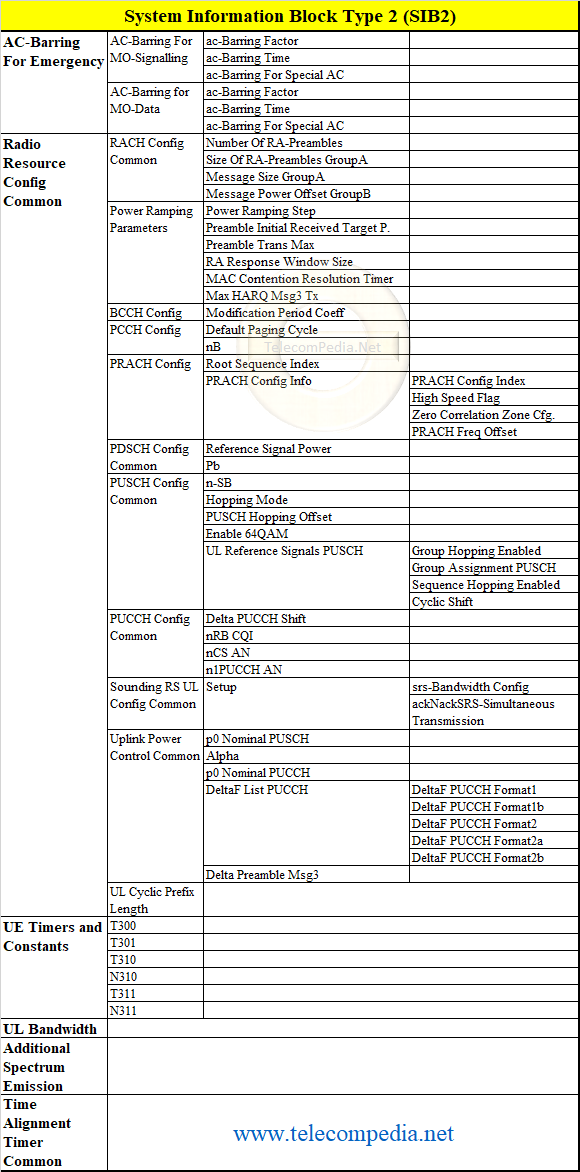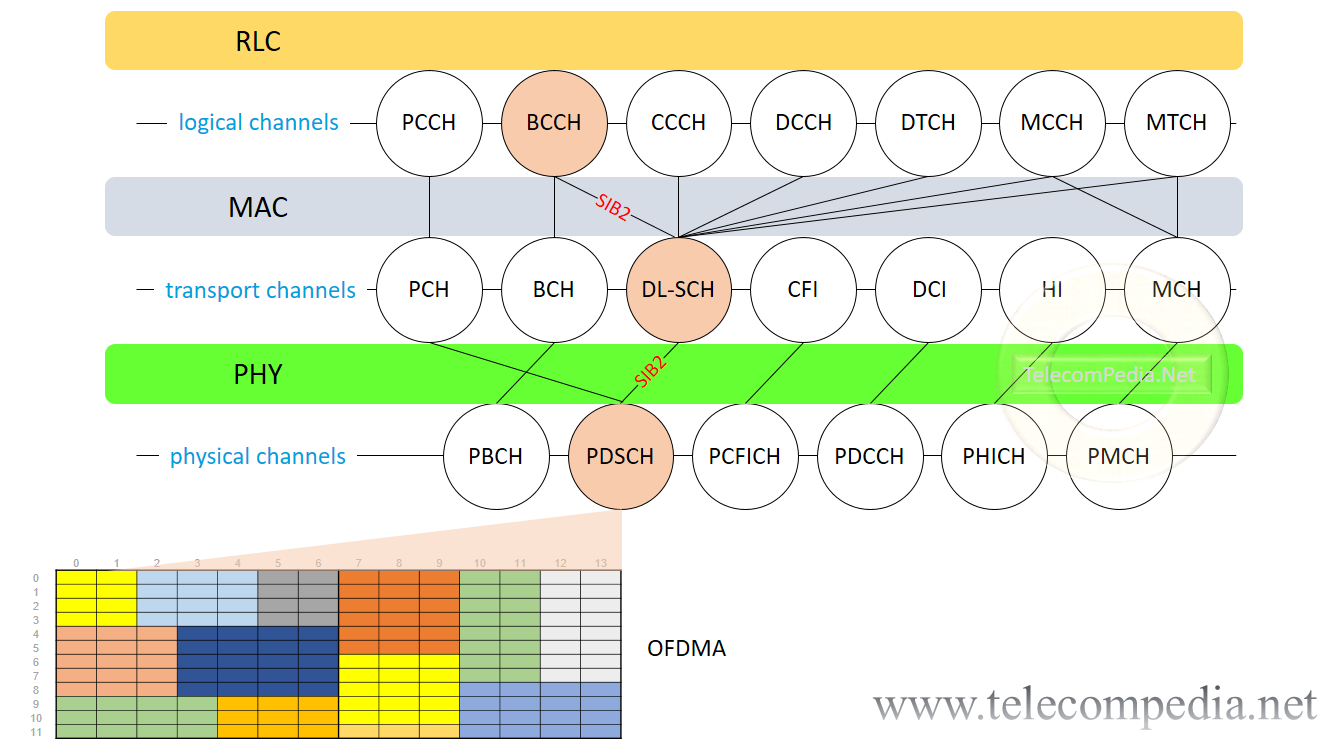System Information Block Type 2 or with shortened version SIB2 contains radio resource configuration information that is common for all UEs, including Access Class Barring configuration, RACH related configuration, Timers, UL Power control, Sounding Reference Signal configuration and etc. SIB2 is transmitted from the network to UE through BCCH -> DL-SCH -> PDSCH channels.
Here the list of carried information from the network to UE through SIB2:
AC-Barring For Emergency: the emergency call barring status of access class 10, indicating whether UEs of access class 10 can initiate emergency calls or not.
AC-Barring For MO-Signaling: access barring information for signaling.
ac-Barring Factor: indicates the access probability factor for signaling.
ac-Barring Time: indicates the average access barring duration for signaling.
ac-Barring For Special AC: “false” or ”true”. Signaling is applied for special Access classes (CSFB, VoLTE etc.).
AC-Barring for MO-Data: access barring information for mobile-originated calls.
ac-Barring Factor: indicates the access probability factor for mobile-originated calls.
ac-Barring Time: indicates the average access barring duration for mobile-originated calls.
ac-Barring For Special AC: “false” or ”true”. Mobile-originated call is applied for special Access classes (CSFB, VoLTE etc.).
RACH Config Common: contains parameters related to RACH configuration at the MAC level across the cell.
Number Of RA-Preambles: number of non-dedicated random access preambles.
Size Of RA-Preambles GroupA: number of non-dedicated random access preambles in Random Acces Preambles group A.
Message Size GroupA: threshold for determining the size of message when a UE selects a preamble from random access preamble group A during a random access procedure.
Message Power Offset GroupB: power offset for selection preambles from Group B.
Power Ramping Parameters: indicates the steps for UE power where random access preambles is increased each time after a RACH access failure.
Power Ramping Step: if multiple attempts to access the PRACH fail, the UE increases power for random access preambles by a step specified by this parameter.
Preamble Initial Received Target Power: initial UE transmit power for the PRACH which is expected by the eNodeB.
Preamble Trans Max: maximum number of preamble transmission to achieve success.
RA Response Window Size: duration of RA response window.
MAC Contention Resolution Timer: time when a UE waits for Msg4 during a random access procedure. This timer starts when a UE initially sends or resends Msg3.
Max HARQ Msg3 Tx: Maximum number of Msg3 HARQ transmissions.
BCCH Config: configuration information of the Broadcast Control Channel.
Modification Period Coeff: modification period coefficient for the BCCH. BCCH modification period is equal to Modification period coefficient multiplies default DRX cycle.
PCCH Config: configuration information of the Paging Control Channel.
Default Paging Cycle: default paging period for the cell. It is also known as DRX cycle.
nB: number of paging occurrences within a paging period.
PRACH Config: configuration information of the Physical Random Access Channel.
Root Sequence Index: used to determine 64 physical RACH preamble sequences available in the cell.
PRACH Config Index: this provides the exact position of random access preamble when needs to be send by UE.
High Speed Flag: indicates the speed flag of the cell where the cell serves high-speed railway or other scenarios.
Zero Correlation Zone Config.: indicates the length index for the Zadoff-Chu sequence that generates the random access preamble.
PRACH Freq Offset: shows starting frequency-domain position of the PRACH Physical Resource Blocks.
PDSCH Config Common: contains parameters related to configuration of PDSCH.
Reference Signal Power: cell reference signal or also known as energy per resource element for reference signal.
Pb: used to calculate power difference between Reference Signal and PDSCH.
PUSCH Config Common: contains parameters related to PUSCH configuration.
n-SB: indicates the number of PUSCH sub-bands.
Hopping Mode: Inter Sub-Frame, Intra and Inter Sub-Frame, indicates the hopping mode of the PUSCH.
PUSCH Hopping Offset: indicates the hopping offset of the PUSCH (0-98).
Enable 64QAM: indicates whether 64QAM of the PUSCH is enabled (true/false).
Group Hopping Enabled: indicates whether group hopping of the PUSCH is enabled (true/false).
Group Assignment PUSCH: indicates the group assignment of the PUSCH (0-29).
Sequence Hopping Enabled: indicates whether sequence hopping of the PUSCH is enabled (true/false).
Cyclic Shift: indicates the cyclic shift to use for deriving the uplink demodulation reference signal from the base sequence.
PUCCH Config Common: contains parameters related to common PUCCH configuration.
Delta PUCCH Shift: indicates the interval between cyclic shifts used for the PUCCH.
nRB CQI: denotes the bandwidth in terms of resource blocks that are available for use by PUCCH formats 2/2a/2b transmission in each slot.
nCS AN: number of cyclic shift used for PUCCH formats 1/1a/1b in a resource block used for a mix of formats 1/1a/1b and 2/2a/2b.
n1PUCCH AN: parameter used to determine resources used for transmission of PUCCH format 1/1a/1b and 2/2a/2b.
Sounding RS UL Config Common: this parameter indicates whether UL Sounding RS is enabled (TRUE) or not (FALSE).
srs-Bandwidth Config: denotes an index into tables with cell specific SRS Bandwidth Configuration.
ackNackSRS-Simultaneous Transmission: defines whether a UE can simultaneously transmit SRS and ACK/NACK (true) or not (false).
Uplink Power Control Common: contains parameters used for computing UL power.
p0 Nominal PUSCH: the parameter used to compute the UL UE transmit power for transmission on PUSCH for semi-persistent grants.
Alpha: used to compute the UL UE transmit power for transmission on PUSCH.
p0 Nominal PUCCH: the parameter used to compute the UL UE transmit power for transmission on PUCCH.
Delta Preamble Msg3: the parameter used to compute the UL UE transmit power for transmission of random access response grant.
UL Cyclic Prefix Length: value len1 corresponds to normal CP and len2 corresponds to extended CP.
UE Timers and Constants: set of proposed RRC timers and constant parameters.
T300: interval between subsequent transmissions of RRCConnectionRequest.
T301: interval between subsequent transmissions of RRCConnectionReestablishmentRequest.
T310: radio link failure declaration timer (*N310 out of sync indications).
N310: number of consecutive “out-of-sync” indications received from lower layers that triggers timer T310.
T311: radio link failure recovery timer (connection re-establishment procedure).
N311: number of consecutive “in-sync” indications received from lower layers that stops timer T310.
UL Bandwidth: uplink transmission bandwidth. n6 corresponds to 6 resource blocks, n15 to 15 resource blocks and so on.
Additional Spectrum Emission: the additional spectrum emission, which restricts the emission power of the UEs in the cell.
Time Alignment Timer Common: length of the uplink time alignment timer for UEs in the cell. A UE is considered not time-aligned in the uplink if the timer expires.
SIB2 carried information:

Example for SIB2, taken from drive-test tool:
radioResourceConfigCommon
rach-ConfigCommon
numberOfRA-Preambles : n52
sizeOfRA-PreamblesGroupA : n28
messageSizeGroupA : b56
messagePowerOffsetGroupB : dB10
powerRampingParameters
powerRampingStep : dB2
preambleInitialReceivedTargetPower : dBm-104
preambleTransMax : n10
ra-ResponseWindowSize : sf10
mac-ContentionResolutionTimer : sf64
maxHARQ-Msg3Tx : 5
bcch-Config
modificationPeriodCoeff : n2
pcch-Config
defaultPagingCycle : rf128
nB : oneT
prach-Config
rootSequenceIndex : 24
prach-ConfigInfo
prach-ConfigIndex : 6
highSpeedFlag : False
zeroCorrelationZoneConfig : 11
prach-FreqOffset : 6
pdsch-ConfigCommon
referenceSignalPower : 15
p-b : 0
pusch-ConfigCommon
n-SB : 4
hoppingMode : interSubFrame
pusch-HoppingOffset : 22
enable64QAM : False
ul-ReferenceSignalsPUSCH
groupHoppingEnabled : False
groupAssignmentPUSCH : 0
sequenceHoppingEnabled : False
cyclicShift : 0
pucch-ConfigCommon
deltaPUCCH-Shift : ds1
nRB-CQI : 1
nCS-AN : 0
n1PUCCH-AN : 18
soundingRS-UL-ConfigCommon
SoundingRS-UL-ConfigCommon : release
uplinkPowerControlCommon
p0-NominalPUSCH : -67
alpha : al07
p0-NominalPUCCH : -115
deltaFList-PUCCH
deltaF-PUCCH-Format1 : deltaF0
deltaF-PUCCH-Format1b : deltaF3
deltaF-PUCCH-Format2 : deltaF1
deltaF-PUCCH-Format2a : deltaF2
deltaF-PUCCH-Format2b : deltaF2
deltaPreambleMsg3 : 4
ul-CyclicPrefixLength : len1
ue-TimersAndConstants
t300 : ms1000
t301 : ms200
t310 : ms1000
n310 : n10
t311 : ms10000
n311 : n1
ul-Bandwidth : n75
additionalSpectrumEmission : 1
timeAlignmentTimerCommon : infinity
* Note: there are some parameters which might not be seen in the message list from drive-test tool, so it means this parameter was not configured in the network by the engineers.

Valuable information,
Thanks
Please explain “RRC connections setup IEs”